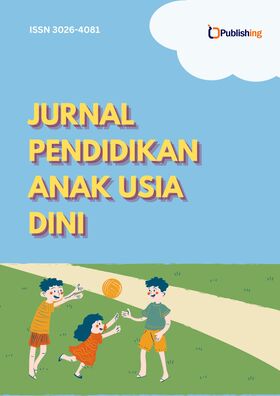Pengembangan Media Pembelajaran Inovatif untuk Menstimulasi Keterampilan Gerak Lokomotor Anak Usia 5-6 Tahun
DOI:
https://doi.org/10.47134/paud.v1i2.70Keywords:
innovative learning media, locomotor skills, early childhoodAbstract
This study aims to develop innovative learning media to stimulate locomotor skills in children aged 5-6 years. The research employs the ADDIE development model (Analysis, Design, Development, Implementation, and Evaluation). Questionnaires are used as instruments for expert reviews, and one-on-one evaluation tools are used for children aged 5-6 years. The results of the product's validity test by content experts obtained a final score of 98.2%. The validity test results by media experts received a final score of 93.7%. The product testing on children aged 5-6 years resulted in a final score of 91.6%. The research findings indicate that the innovative learning media named "MONOPOLI GEMASI (Moving and Imaginative Monopoly)" meets the requirements. This innovative learning media successfully stimulates locomotor skills in children aged 5-6 years. It provides physical activity content for children, including walking, running, jumping, leaping, and crawling. This media can be practically used as a learning tool at home and in early childhood education institutions.
References
Adawiyah, R. (2022). Pengaruh Permainan Monopoli Card Terhadap Kemampuan Motorik Kasar Anak Usia 5-6 Tahun. Jurnal Golden Age, 313-321. DOI: https://doi.org/10.31004/obsesi.v6i3.1896
Ali, A. (2021). The effect of a 10-week physical activity programme on fundamental movement skills in 3–4-year-old children within early childhood education centres. Children, 8(6). https://doi.org/10.3390/children8060440 DOI: https://doi.org/10.3390/children8060440
Asmariani. (2016). Konsep Media Pembelajaran PAUD. Jurnal Al-Afkar, 26. DOI: https://doi.org/10.28944/afkar.v5i1.108
Buckler, E. J. (2021). Examining the knowledge base and level of confidence of early childhood educators in physical literacy and its application to practice. Early Years, 41(2), 202–217. https://doi.org/10.1080/09575146.2018.1514488 DOI: https://doi.org/10.1080/09575146.2018.1514488
Dobell, A. (2020). Fundamental movement skills and accelerometer-measured physical activity levels during early childhood: A systematic review. Children, 7(11). https://doi.org/10.3390/children7110224 DOI: https://doi.org/10.3390/children7110224
Fatmawati, F. A. (2020). Pengembangan Fisik Motorik Anak Usia Dini. Gresik: Caremedia Communication.
Guslinda, & Kurnia, R. (2018). Media Pembelajaran Anak Usia Dini. Surabaya: CV Jakad Publishing Surabaya. DOI: https://doi.org/10.31227/osf.io/4c2hx
Hall, C. J. S. (2019). Does perception of motor competence mediate associations between motor competence and physical activity in early years children? Sports, 7(4). https://doi.org/10.3390/sports7040077 DOI: https://doi.org/10.3390/sports7040077
Kavanagh, J. A. (2020). Quantifying cycling as a foundational movement skill in early childhood. Journal of Science and Medicine in Sport, 23(2), 171–175. https://doi.org/10.1016/j.jsams.2019.08.020 DOI: https://doi.org/10.1016/j.jsams.2019.08.020
Komaini, A. (2022). DEVELOPMENT OF BASIC MOVEMENT SKILLS TEST INSTRUMENTS FOR EARLY CHILDHOOD. Physical Education Theory and Methodology, 22(4), 493–499. https://doi.org/10.17309/tmfv.2022.4.06 DOI: https://doi.org/10.17309/tmfv.2022.4.06
Lane, C. (2022). Exploring a parent-focused physical literacy intervention for early childhood: a pragmatic controlled trial of the PLAYshop. BMC Public Health, 22(1). https://doi.org/10.1186/s12889-022-13048-5 DOI: https://doi.org/10.1186/s12889-022-13048-5
Li, F. (2022). Examining Relationships among Chinese Preschool Children’s Meeting 24-Hour Movement Guidelines and Fundamental Movement Skills. Journal of Clinical Medicine, 11(19). https://doi.org/10.3390/jcm11195623 DOI: https://doi.org/10.3390/jcm11195623
Norhana Bt Mohamad Saad, W. A. M. B. W. A. F. (2022). Factors Influencing Early Retirement Intention of Teacher Leaders in Secondary Schools. International Journal of Social Learning (IJSL), 2(2), 161–172. https://doi.org/10.47134/ijsl.v2i2.67 DOI: https://doi.org/10.47134/ijsl.v2i2.67
Nurani, Y. (2019). Perspektif Baru Konsep Dasar Pendidikan Anak usia Dini. Jakarta: PT. Indeks.
Raharjo, B., Amalia, R., & Satriana, M. (2021). Penerapan Metode Demonstrasi Gerak Lokomotor Dalam Mengembangkan Motorik Kasar Anak Usia Dini. Banyumas: Amerta Media.
Siregar, N. M. (2021). The basic learning model of traditional motion based games for early childhood (5-6) years. International Journal of Human Movement and Sports Sciences, 9(1), 81–88. https://doi.org/10.13189/saj.2021.090111 DOI: https://doi.org/10.13189/saj.2021.090111
Sithulisiwe Bhebhe, N. V. (2021). Early Childhood Education Services in Manzini Region in Eswatini: Equality and Accessibility. International Journal of Social Learning (IJSL), 1(2), 172–186. https://doi.org/10.47134/ijsl.v1i2.47 DOI: https://doi.org/10.47134/ijsl.v1i2.47
Sugiyono. (2019). Metode Penelitian Kuantitatif, Kualitatif, dan R&D. Bandung: Penerbit Alfabeta.
Sukamti, E. R. (2018). Perkembangan Motorik. Yogyakarta: UNY Press.
Sutapa, P. (2021). Improving motor skills in early childhood through goal-oriented play activity. Children, 8(11). https://doi.org/10.3390/children8110994 DOI: https://doi.org/10.3390/children8110994
Wainwright, N. (2020). Developing children’s motor skills in the Foundation Phase in Wales to support physical literacy. Education 3-13, 48(5), 565–579. https://doi.org/10.1080/03004279.2019.1633374 DOI: https://doi.org/10.1080/03004279.2019.1633374
Downloads
Published
How to Cite
Issue
Section
License
Copyright (c) 2023 Hani Julianti, Yuliani Nurani, Niken Pratiwi

This work is licensed under a Creative Commons Attribution 4.0 International License.










